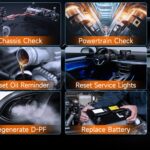Tuning your car in Forza Horizon 5 can dramatically improve its performance and handling. This comprehensive guide breaks down every tuning option, from tire pressure to differentials, providing you with the knowledge to transform your car into a racing machine. Whether you’re a seasoned tuner or just starting out, this guide will help you master the art of tuning in Forza Horizon 5.
Forza Horizon 5 Tuning Menu: Your Gateway to Performance Enhancement
Understanding Tire Tuning in Forza Horizon 5
Tires are your car’s only connection to the road, making them crucial for performance. Proper tire tuning maximizes grip and responsiveness.
Choosing the Right Tire Compound
Forza Horizon 5 simplifies tire compounds, focusing primarily on grip levels. Upgraded compounds offer superior grip, especially beneficial for tight, technical tracks. For high-speed tracks, street or sport compounds suffice, allowing you to prioritize power upgrades or weight reduction.
Finding the Optimal Tire Pressure
Achieving the ideal tire pressure involves a simple process:
- Set initial “cold” pressure between 27-30 PSI (1.90-2.07 Bar).
- Warm up tires for a minute or two.
- Use telemetry’s Tires, Misc. screen to check warm pressure. Aim for 32-34 PSI (2.20-2.35 Bar).
- Adjust pressure settings in the tuning menu until reaching the target range.
- Recheck after suspension adjustments.
Telemetry is Your Friend: Use it to Monitor Tire Temperature and Pressure
Mastering Camber Adjustments
Camber, the inward or outward tilt of the tire, significantly impacts handling. Negative camber (tops leaning inward) enhances grip during cornering.
Tuning Camber for Optimal Grip
- Start with -1.0 to -1.5 degrees of camber.
- Analyze tire temperatures using the “Heat” telemetry view after cornering.
- Increase negative camber if the outside tire edge is hotter. Reduce it if the inside edge is hotter.
- Aim for even tire heating as you exit turns.
Detailed Tire Temperature Analysis: Essential for Fine-tuning Camber
Don’t exceed -2.0 degrees of front camber without adjusting caster.
Fine-tuning Toe and Caster
While less critical than camber and tire pressure, toe and caster still contribute to handling.
Toe: Minor Adjustments for Specific Needs
Toe, the inward or outward angle of the tires when viewed from above, requires minimal adjustments. Generally, zero toe is recommended for both front and rear. In specific cases, slight toe-out in the front can improve turn-in for front-wheel-drive cars, while slight toe-in at the rear can reduce oversteer in rear-wheel-drive cars.
Caster: Enhancing Stability
Caster, the angle of the steering axis, primarily affects straight-line stability. A setting between 5.0 and 6.0 degrees generally works well. Higher values increase stability but can make the car feel snappy during turn-in. Forza Horizon 5 is particularly sensitive to caster adjustments.
Suspension Tuning: Springs, Anti-Roll Bars, and Dampers
Suspension tuning is key to maximizing tire contact with the road.
Spring Rates: Balancing Comfort and Performance
Springs control how the car reacts to bumps. Stiffer springs reduce body roll but can cause the car to skip over bumps. Softer springs improve ride quality but can bottom out. Tuning involves finding the right balance for your car and driving style. Consider factors like vehicle weight, ride height, and track surface.
Anti-Roll Bars (ARBs): Fine-tuning Mid-Corner Handling
ARBs connect opposite wheels, reducing body roll during cornering. Stiffer ARBs improve responsiveness but can make the ride harsher. Tune ARBs to address oversteer or understeer. Reduce front ARB stiffness to reduce understeer and reduce rear ARB stiffness to reduce oversteer.
Dampers: Controlling Suspension Movement
Dampers control the speed of suspension compression and rebound. They keep the car stable during braking, cornering, and acceleration. Stiffer dampers provide better control on smooth tracks but can be detrimental on bumpy surfaces. Adjust dampers in conjunction with spring and ARB settings.
Aerodynamics: Downforce for High-Speed Grip
Aerodynamic upgrades generate downforce, increasing grip at higher speeds. However, they also increase drag, reducing top speed. Consider the track layout and your driving style when tuning aero. High-speed corners benefit from increased downforce, while long straights favor reduced downforce.
Aero Tuning: Finding the Balance Between Downforce and Drag
Brake Tuning: Balancing and Pressure
Upgrading to race brakes allows for adjustments to brake balance and pressure. Brake balance distributes braking force between front and rear wheels. Adjust it to address brake lockup or improve turn-in. Brake pressure determines the force required to activate the brakes. Adjust it to match your driving style and preferences.
Differential Tuning: Optimizing Power Delivery
Differentials manage power distribution between wheels, crucial for accelerating out of corners. Higher differential settings increase lock, improving traction but potentially causing understeer. Lower settings allow for more wheel independence, improving cornering but potentially reducing acceleration. Tune differentials based on your drivetrain (FWD, RWD, AWD) and driving style.
Conclusion
Tuning in Forza Horizon 5 is a complex but rewarding process. This guide provides a solid foundation for understanding the various tuning options and their impact on performance. Experimentation and practice are key to finding the optimal setup for your car and driving style. Remember, telemetry is your invaluable tool for analyzing your car’s behavior and making informed tuning decisions. For a faster and more automated tuning experience, consider using tuning calculator apps like ForzaTune.

